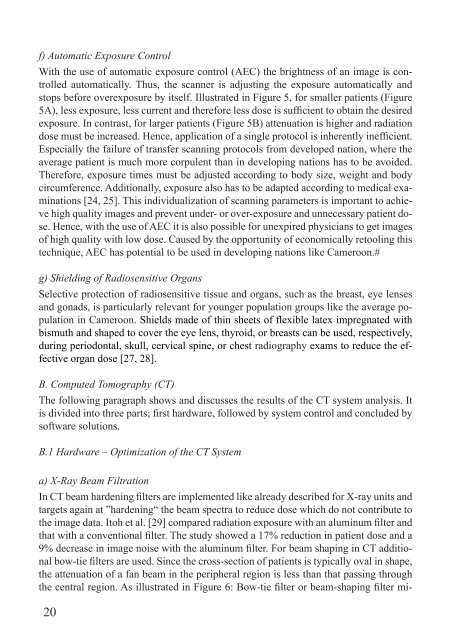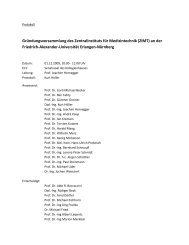Aspects of Green Hospital Approaches with a Focus on Developing ...
Aspects of Green Hospital Approaches with a Focus on Developing ...
Aspects of Green Hospital Approaches with a Focus on Developing ...
Sie wollen auch ein ePaper? Erhöhen Sie die Reichweite Ihrer Titel.
YUMPU macht aus Druck-PDFs automatisch weboptimierte ePaper, die Google liebt.
f) Automatic Exposure C<strong>on</strong>trol<br />
With the use <str<strong>on</strong>g>of</str<strong>on</strong>g> automatic exposure c<strong>on</strong>trol (AEC) the brightness <str<strong>on</strong>g>of</str<strong>on</strong>g> an image is c<strong>on</strong>trolled<br />
automatically. Thus, the scanner is adjusting the exposure automatically and<br />
stops before overexposure by itself. Illustrated in Figure 5, for smaller patients (Figure<br />
5A), less exposure, less current and therefore less dose is sufficient to obtain the desired<br />
exposure. In c<strong>on</strong>trast, for larger patients (Figure 5B) attenuati<strong>on</strong> is higher and radiati<strong>on</strong><br />
dose must be increased. Hence, applicati<strong>on</strong> <str<strong>on</strong>g>of</str<strong>on</strong>g> a single protocol is inherently inefficient.<br />
Especially the failure <str<strong>on</strong>g>of</str<strong>on</strong>g> transfer scanning protocols from developed nati<strong>on</strong>, where the<br />
average patient is much more corpulent than in developing nati<strong>on</strong>s has to be avoided.<br />
Therefore, exposure times must be adjusted according to body size, weight and body<br />
circumference. Additi<strong>on</strong>ally, exposure also has to be adapted according to medical examinati<strong>on</strong>s<br />
[24, 25]. This individualizati<strong>on</strong> <str<strong>on</strong>g>of</str<strong>on</strong>g> scanning parameters is important to achieve<br />
high quality images and prevent under- or over-exposure and unnecessary patient dose.<br />
Hence, <str<strong>on</strong>g>with</str<strong>on</strong>g> the use <str<strong>on</strong>g>of</str<strong>on</strong>g> AEC it is also possible for unexpired physicians to get images<br />
<str<strong>on</strong>g>of</str<strong>on</strong>g> high quality <str<strong>on</strong>g>with</str<strong>on</strong>g> low dose. Caused by the opportunity <str<strong>on</strong>g>of</str<strong>on</strong>g> ec<strong>on</strong>omically retooling this<br />
technique, AEC has potential to be used in developing nati<strong>on</strong>s like Camero<strong>on</strong>.#<br />
g) Shielding <str<strong>on</strong>g>of</str<strong>on</strong>g> Radiosensitive Organs<br />
Selective protecti<strong>on</strong> <str<strong>on</strong>g>of</str<strong>on</strong>g> radiosensitive tissue and organs, such as the breast, eye lenses<br />
and g<strong>on</strong>ads, is particularly relevant for younger populati<strong>on</strong> groups like the average populati<strong>on</strong><br />
in Camero<strong>on</strong>. Shields made <str<strong>on</strong>g>of</str<strong>on</strong>g> thin sheets <str<strong>on</strong>g>of</str<strong>on</strong>g> flexible latex impregnated <str<strong>on</strong>g>with</str<strong>on</strong>g><br />
bismuth and shaped to cover the eye lens, thyroid, or breasts can be used, respectively,<br />
during period<strong>on</strong>tal, skull, cervical spine, or chest radiography exams to reduce the effective<br />
organ dose [27, 28].<br />
B. Computed Tomography (CT)<br />
The following paragraph shows and discusses the results <str<strong>on</strong>g>of</str<strong>on</strong>g> the CT system analysis. It<br />
is divided into three parts; first hardware, followed by system c<strong>on</strong>trol and c<strong>on</strong>cluded by<br />
s<str<strong>on</strong>g>of</str<strong>on</strong>g>tware soluti<strong>on</strong>s.<br />
B.1 Hardware – Optimizati<strong>on</strong> <str<strong>on</strong>g>of</str<strong>on</strong>g> the CT System<br />
a) X-Ray Beam Filtrati<strong>on</strong><br />
In CT beam hardening filters are implemented like already described for X-ray units and<br />
targets again at ”hardening“ the beam spectra to reduce dose which do not c<strong>on</strong>tribute to<br />
the image data. Itoh et al. [29] compared radiati<strong>on</strong> exposure <str<strong>on</strong>g>with</str<strong>on</strong>g> an aluminum filter and<br />
that <str<strong>on</strong>g>with</str<strong>on</strong>g> a c<strong>on</strong>venti<strong>on</strong>al filter. The study showed a 17% reducti<strong>on</strong> in patient dose and a<br />
9% decrease in image noise <str<strong>on</strong>g>with</str<strong>on</strong>g> the aluminum filter. For beam shaping in CT additi<strong>on</strong>al<br />
bow-tie filters are used. Since the cross-secti<strong>on</strong> <str<strong>on</strong>g>of</str<strong>on</strong>g> patients is typically oval in shape,<br />
the attenuati<strong>on</strong> <str<strong>on</strong>g>of</str<strong>on</strong>g> a fan beam in the peripheral regi<strong>on</strong> is less than that passing through<br />
the central regi<strong>on</strong>. As illustrated in Figure 6: Bow-tie filter or beam-shaping filter mi-<br />
20




